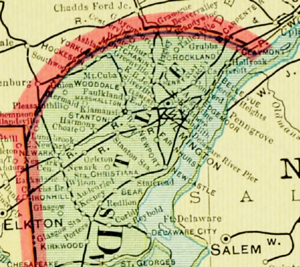Farnhurst, Delaware facts for kids
Quick facts for kids
Farnhurst, Delaware
|
|
|---|---|
| Country | United States |
| State | Delaware |
| County | New Castle |
| Elevation | 43 ft (13 m) |
| Time zone | UTC-5 (Eastern (EST)) |
| • Summer (DST) | UTC-4 (EDT) |
| Area code(s) | 302 |
| GNIS feature ID | 216946 |
Farnhurst is a small, unincorporated community located in New Castle County, Delaware, in the United States. This means it's a place where people live, but it doesn't have its own local government like a city or town. Farnhurst has a rich history, once being home to important hospitals, a post office, a school, and even a train station.
Contents
Where is Farnhurst?
Farnhurst is found where three major roads meet: Interstate 295, U.S. Route 13, and U.S. Route 40. It is about 2.2 miles (3.5 km) north of New Castle.
Farnhurst's History
Late 1800s: Early Hospitals and a Post Office
Farnhurst became known as the location of the Delaware State Hospital. This was a special hospital that opened in 1889 to help people with mental health needs. It was often simply called "Farnhurst" because it was the main building there. Another important place, the New Castle County Almshouse/Hospital, also operated in Farnhurst from 1884 to 1933. An almshouse was a place that offered shelter and care to poor people. These two large institutions were right next to each other.
A post office opened in Farnhurst on January 15, 1890. This new post office likely caused the nearby Hares Corner post office to close. In the 1930s, the Farnhurst post office moved onto the grounds of the psychiatric hospital.
By 1898, a stagecoach (a horse-drawn carriage for passengers) ran three times a week between Wilmington and Farnhurst. There was even a plan to build a trolley system to connect Farnhurst to Wilmington. A round-trip coach ride between the two places cost twenty cents back then.
In the late 1800s and early 1900s, the Farnhurst Asylum (another name for the hospital) even had its own baseball team! They played against other teams, like the Wilmington Actives.
Early 1900s: A Growing Community
In 1901, newspapers announced that a small village was being created in Farnhurst. This village was built to house the workers who were building the Philadelphia, Baltimore and Washington Railroad. About 25 new buildings, which were described as sheds, were built very quickly. That same year, the P.B.& W. train line in Farnhurst was improved. Workers made the curves of the railroad smoother and leveled out the steep parts. They also made the train station look nicer by adding flower beds and landscaping.
By 1904, Farnhurst was known as a "post village" because it had a post office and a train station on the Philadelphia, Baltimore and Washington Railroad. The train station was mainly there to serve the hospital and the nearby almshouse.
In 1912, a court in Delaware made an important decision. They ruled that old soldiers living in the Farnhurst almshouse were allowed to vote. The Wilmington Journal newspaper reported that "the court decided the old soldiers have a right to vote and the people will see that the men get their votes in the box and are counted."
In 1920, Farnhurst had a population of 332 people. Around this time, the State Hospital had 541 people, and the New Castle County Almshouse had 220 people.
In 1934, a cemetery called Gracelawn Memorial Park opened across the highway from the two hospitals.
A new chapel was finished at the State Hospital in 1939. This building project was part of the Works Progress Administration (WPA), a government program that created jobs during the Great Depression. The building was completed in September of that year. In 1940, Farnhurst's population was 250.
Late 1900s: Changes and Closures
The older cemetery on the hospital and almshouse grounds was mostly removed in the 1950s and 1960s. This happened because new highways were being built for the Farnhurst interchange, which connects to the Delaware Memorial Bridge.
The Farnhurst post office closed in 1958. In 1961, the old hospital/almshouse building, which had been renamed the New Castle Building after its closure in 1933, burned down completely.
In 1960, Farnhurst's population was 350.
The Farnhurst School building was still standing in the 1980s. Since 1978, this building has been used as the Howard J. Weston Senior Center. It is now part of the Wilmington Manor census-designated place (a specific area defined by the U.S. Census Bureau for statistical purposes).




